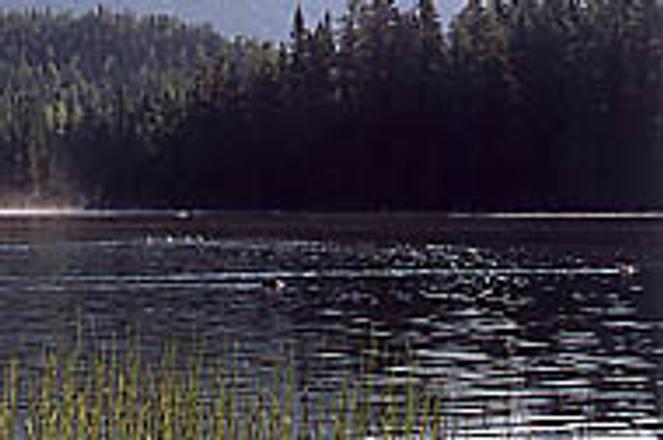Global warming and urbanisation is causing Slovakia to lose 1% of its water per year, says Kravčík.photo: Chris Togneri
Slovak environmentalist Michal Kravčík recently presented his "New Theory of Global Warming" at an environmental conference in Vancouver, British Columbia. His theory states that due to shifts in the earth's weather patterns and excessive industrial and urban development over the past 50 years, Slovakia, along with the rest of the world, is steadily losing its water supply.
"The industrialisation and urbanisation of Slovakia was begun after the end of World War II," Kravčík said. "Ecologically stabilising elements - such as bogs, spread-out green areas and groves of trees - were removed from the country's environmental structure. More than 500,000 hectares of agricultural land has since then been drained and more than 8,000 kilometres of [natural] watercourses have been canalised."
As the country's natural surface has been gradually covered over with concrete, a process accelerated during Communism from 1948 to 1989, less water is able to penetrate the soil and join natural underground water reserves. Instead, water is increasingly falling on cement urban centres and in the more than 15,000 kilometres of concrete "water-catching drains" that have been constructed since 1950. The water then drains into rivers, where it is taken out of Slovakia and ultimately to the oceans.
"As a result, Slovakia alone is losing 1% of its water [it would naturally receive] every year," he said. "This is about 250 million cubic metres of water per year."
Compounding matters are changes to weather patterns, he continued, which are altering natural rainfall trends. High mountainous regions are receiving more rain, flatlands are receiving less, while precipitation is falling more infrequently during the winter months and more often in torrential summer downpours, often resulting in massive flooding, which in turn contributes to the runoff of water.
Flooding in 1998 killed 48 people in Slovakia, while this year it has so far caused over one billion crowns ($20 million) in damages.
Kravčík said that the 1% annual loss of the country's water began some 50 years ago and that, therefore, Slovakia's natural water supply could be exhausted within 50 years. If trends are not reversed, he warned, the resulting water circle would be one of massive flooding whenever rain fell, and severe drought at other times.
While his theory forecast a virtually uninhabitable Slovak climate within the foreseeable future, Kravčík added that a reversal of the problem was possible.
"This is a simple problem to solve," he said. "Everyone just has to realise that whenever one area is covered up with concrete, another area for water accumulation must be created."
Limited reaction
Michal Kravčík is an internationally-respected environmentalist who founded the Košice-based Ľudia a voda (People and Water) non-governmental organisation in 1993, and was awarded the 1999 Goldman environmentalist award for his work on creating sustainable environments in the Carpathian region of central Europe.
Yet Kravčík has rarely received as much praise at home as he has abroad, leaving other environmental activists in the country to wonder if his New Theory on Global Warming would be taken seriously.
Michal Deraj of the Danish Environmental Protection Agency and a former employee of several Slovak environmental NGOs said that although he was unfamiliar with the specifics of Kravčík's theory, the People and Water head would have to prove it scientifically before he could expect support.
"From my knowledge, Mr. Kravčík's theory makes sense, but it's hard to determine how it could affect water cycles," he said. "The more pavement which covers the land, the quicker the run-off of rainfall is. And, of course, in the countryside if you don't have water accumulation areas, such as bogs and wetlands, water runoff is also increased."
Deraj added: "He is a well-respected environmentalist, but this is only a theory of his. It must be verified scientifically rather than intuitively."
Greenpeace Slovakia head Ľubica Trubíniová said that the ideas behind Kravčík's theory were sound, but that she was not confident that Slovaks would listen his warning.
"In terms of sustainability, his ideas are right on," she said. "It's clear that when you cover surfaces with concrete it decreases the potential for a natural water cycle. In theory, the idea is sound.
"The problem is that here in Slovakia environmental issues are usually disregarded," she continued. "Action is not taken against environmental problems unless there is a measurable social or economic impact on people."
Slovaks would also likely reject the new theory, Trubíniová added, because Kravčík delivers messages in a manner she termed "without diplomacy".
"He has courageous ideas and he is a person who presents his ideas directly. But here in Slovakia, people sometimes criticise him and his ideas because, perhaps, 'At home, nobody is a prophet'," she said, quoting a Slovak saying.
"But people should listen to his theory carefully and think deeply about his ideas. He is on the right path with this theory, and it should not be simply disregarded. But I am very sceptical that Slovakia will listen to him."


